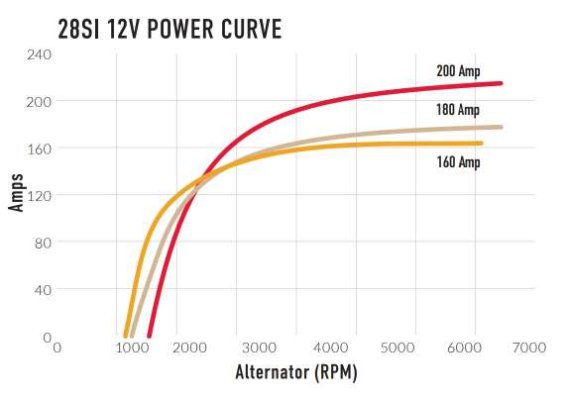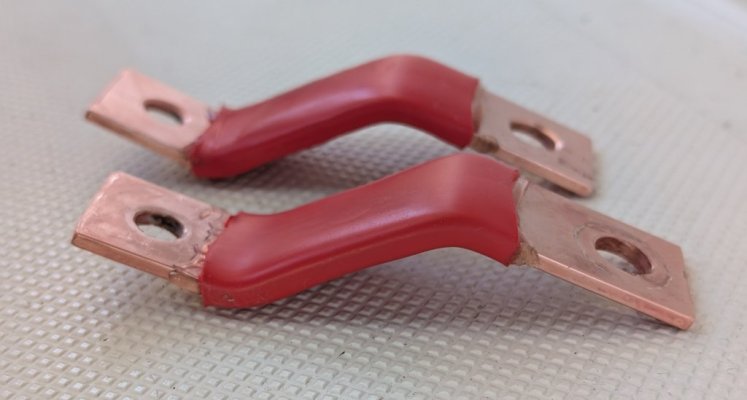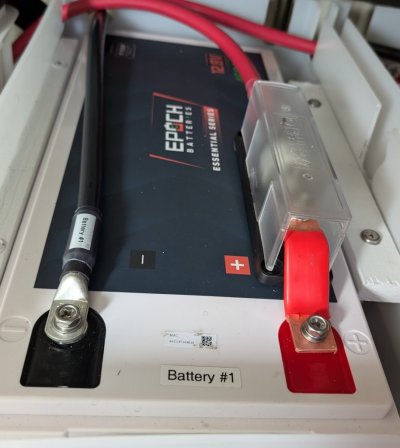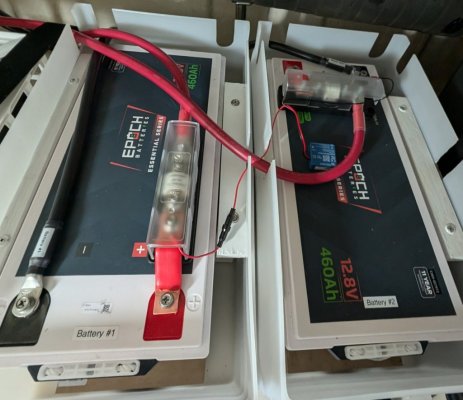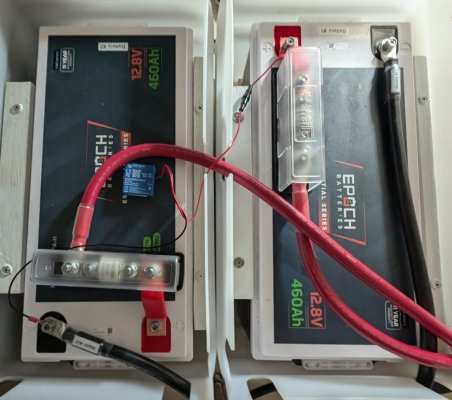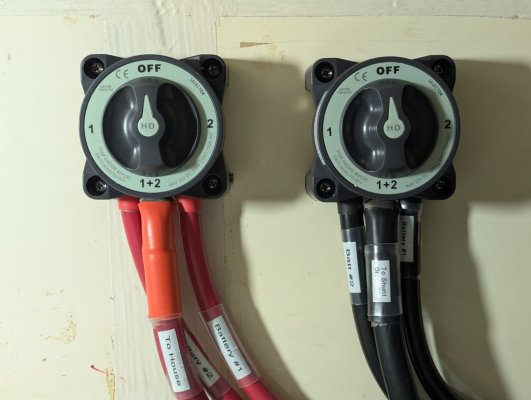dhays
Guru
- Joined
- May 26, 2015
- Messages
- 9,574
- Location
- Gig Harbor, WA
- Vessel Name
- Kinship
- Vessel Make
- 2010 North Pacific 43
@luna I really appreciate your input as you actually know about this stuff and I'm just guessing and making it up as I go. You have it pretty much pegged.dhays, you may want to reconsider your alternator output circuit.
Consider the typical PNW cruiser who spent the night on the hook and in the morning has his LFP house bank depleted by Steve's 400 Ah's or more. 500-600 Ahs is common overnight on my power hungry ride.
With your described circuits in place, you start the engine and your new 28SI pours it's guts into the thruster bank only, as that's all it's directly connected to.
This helps in bringing the anchor aboard and then while underway at some point (usually not too long) the DC2DC connects the now charged thruster bank to the depleted house bank.
Your new 160A 28SI is loafing along with only an output of 50 A, (thruster bank is full) all of which goes to to the LFP house bank via the 50 A DC2DC. At 50 A, let's just say it will take 8 hours (your house loads are zero) to charge the battery bank that is depleted by 400 Ahs.
Other than possibly a short burst of current into the thruster bank now and again, 50 A of load is all that this 160 A rated alternator will ever see.
Your new 28SI should last a long time as it will likely never overheat with these loads.
The DC2DC on the other hand, is running flat out most of the time.
At some point along this 8 hour charge duration the LFP house bank will get to 13.0 V and then and only then will the Xantrex Echo Charger start to charge the engine start bank.
Up until this point in time the engine start bank has started the engine, ran the intake air heater (if still enabled or equipped) and supplied the engine run loads, which DDW upthread says on his QSB are about 20 Amps, without any charge what so ever.
Even when the Echo Charger engages, it can only supply 15 A, so the engine start bank is still going backwards by 5 A.
So, the question is, do you think your engine start bank can supply all the loads it is asked to supply without seeing a 15 A charge for however long it takes, at a 50 A charge rate, to get your depleted house bank to 13.0 V? For one night, maybe, what about 2 or 3 nights in a row?
If you think it will, then you need to ask yourself, will your instrumentation warn you of a short term low battery condition causing multiple annoying resets, like DDW experienced?
One thing is that the Echo Charge is feeding the start battery from the thruster bank, not the house bank. The reasons are exactly as you outlined. The thruster bank will be brought up to 14.0v pretty quickly. I have a 5 minute timer on the Orion so it won't even start charging the house from the thruster bank until 5 minutes after the engine circuit is engaged. The reasons for this right now are to give the thruster bank most of the alternator power at the beginning when we would be using the thrusters or the windlass.
The Echo Charge at the most sends 15 amps to the start battery.
My boat has been running with the start battery being fed only by the Echo Charge for 6-7 years and the start battery has always done very well. It is an 8 year old 8D and is the healthiest battery on the boat. However, given DDWs experience it is something that I will be watching. Specifically, I now have a Victron battery sensor on the start battery. I am able to monitor its voltage and temperature. I will watch and see what happens with the voltage in the start battery. When the engine is running, I would expect it to get back to 14v relatively quickly and stay there.
I also don't expect that the DC-DC charger will actually give me 50amps on a continuing basis, although it would be nice. The 28Si alternator is a 14.0v alternator and so far in my limited testing, it is right on the nose. However, I don't yet have a remote sense wire connected so it is judging the voltage based on its own output not the voltage at the battery. A remote sense wire would have it adjust its output based on the voltage at the battery. There is very little voltage drop between the alt and the battery, but the remote sense wire will make sure that the alt feeds as much current as it needs to keep it at 14.0v.
However, once the thruster bank hits 14.0v, the output from the alternator will drop significantly. I have yet to find out how much the Orion will actually output once the thruster bank is at 14.0v. My hope is that the Orion will take up to 50amps of current from the thruster bank and the alternator will increase its output correspondingly. Unfortunately, I can't measure the alternator output while running the boat by myself. My wife can't safely get on or off the boat right now so solo is all I've got right now. However, I can monitor the Orion output via the bluetooth app. So I would hope to see that the thruster bank holds at 14.0v and the Orion puts out up to 50amps to charge the house bank. If this is the case, then I know that the alternator is putting out at least 50-65 amps depending on what the Echo Charge is going at the time.
Fortunately/unfortunately, I don't have any house bank at the moment since I've removed the old L16 AGMs. Currently, the solar, Inverter/Charger, and alternator are all charging the thruster bank and the Orion is disconnected. All house loads are being supported by the thruster bank so the boat is operational until I can get the new house batteries. But it means I can't do the testing yet that I would like.
There are some other possibilities that I am considering to be able to put more amps into the future house bank from the thruster bank but until I know what exactly will happen with the above, no sense in speculating now.

